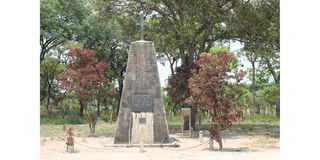I pay a visit to Dr Livingstone memorial in Ujiji

Livingstone memorial in Kigoma. PHOTO | FILE
What you need to know:
- Ujiji is famed for that historical meeting on November 10, 1871, between Henry Morton Stanley and Dr. David Livingstone
My first day in Kigoma began with a courtesy call to Bruno Mpangala, the then Regional Commissioner. If you recall from last week, I gave a narrative in this column on my sojourn to Kigoma in 1980 to cover that year’s Nane Nane Agricultural Show.
After a brief meeting, I decided to begin my day by visiting Ujiji township, some six or so kilometres out of Kigoma town, on the shores of Lake Tanganyika.
I had to because, among other things, Ujiji is famed for that historical meeting on November 10, 1871, between Henry Morton Stanley and Dr. David Livingstone. Stanley, a New York Herald journalist, had been sent by his paper to find Dr Livingstone, a missionary explorer, in deep Africa. “Dr Livingstone I presume,” Stanley is alleged to have greeted Dr Livingstone.
“Yes,” replied the doctor. “I feel thankful to welcome you,” he added. The words are famous for their perceived humour. Livingstone being the only other white person for hundreds of miles, along with Stanley's clumsy attempt at appearing dignified in the bush of Africa by making a formal greeting one might expect to hear in the confines of an upper-class London club.
There is a Livingstone memorial at the place they met in Ujiji. And that is where I visited that day. Despite Stanley’s urgings, Livingstone was determined not to leave Africa. He had arrived in Ujiji a few weeks earlier, on October 23, 1871, from southern and central Africa and had completely lost contact with the outside world for six years.
Dr Livingstone is known as Africa’s greatest missionary, and yet he is recorded as having converted only one African, Sechele, who was the chief of the Kwena people of Botswana.
Sechele, however, was not a staunch Christian on account of his polygamous ways. Dr Livingstone would die two or so years later, on May 1, 1873, at the age of 60, at Chipunda, southwest of Lale Banguela in present day Zambia.
His loyal attendants, Susi and Chuma, removed his heart and buried it under a tree, where now stands another Dr. Livingstone memorial.
An expedition of 79 people, led by the two loyal attendants, carried the rest of his remains for 63 days to the coastal town of Bagamoyo, some 1600 kilometres away. The remains were then transported to London, where he was laid to rest at No. 1 Sevile Row, the Royal Geographical Society’s first office, before being interred at Westminster Abbey.
My visit ended with the attendant at the Ujiji Dr Livingstone Memorial informing me that the names of Ujiji and Kigoma derive from the names of two brothers who settled many years ago in the respective areas, Kajiji and Kagoma.
Indeed, this was a befitting introduction to my sojourn in Kigoma.





